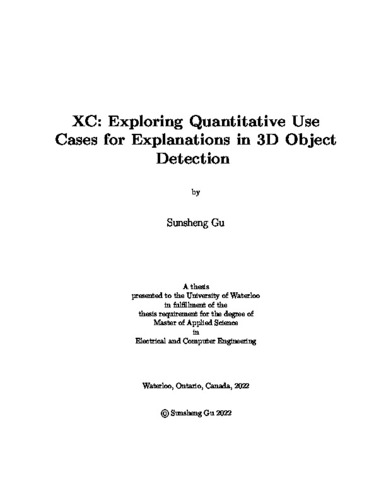UWSpace will be migrating to a new version of its software from July 29th to August 1st. UWSpace will be offline for all UW community members during this time.
XC: Exploring Quantitative Use Cases for Explanations in 3D Object Detection
| dc.contributor.author | Gu, Sunsheng | |
| dc.date.accessioned | 2022-01-18 13:46:58 (GMT) | |
| dc.date.available | 2022-01-18 13:46:58 (GMT) | |
| dc.date.issued | 2022-01-18 | |
| dc.date.submitted | 2022-01-05 | |
| dc.identifier.uri | http://hdl.handle.net/10012/17899 | |
| dc.description.abstract | Explainable AI (XAI) methods are frequently applied to obtain qualitative insights about deep models' predictions. However, such insights need to be interpreted by a human observer to be useful. In this thesis, we aim to use explanations directly to make decisions without human observers. We adopt two gradient-based explanation methods, Integrated Gradients (IG) and backprop, for the task of 3D object detection. Then, we propose a set of quantitative measures, named Explanation Concentration (XC) scores, that can be used for downstream tasks. These scores quantify the concentration of attributions within the boundaries of detected objects. We evaluate the effectiveness of XC scores via the task of distinguishing true positive (TP) and false positive (FP) detected objects in the KITTI and Waymo datasets. The results demonstrate improvement of more than 100\% on both datasets compared to other heuristics such as random guesses and number of LiDAR points in bounding box, raising confidence in XC's potential for application in more use cases. Our results also indicate that computationally expensive XAI methods like IG may not be more valuable when used quantitatively compared to simpler methods. Moreover, we apply loss terms based on XC and pixel attribution prior (PAP), which is another qualitative measure for attributions, to the task of training a 3D object detection model. We show that performance boost is possible as long as we select the right subset of predictions for which the attribution-based losses are applied. | en |
| dc.language.iso | en | en |
| dc.publisher | University of Waterloo | en |
| dc.relation.uri | the KITTI Vision Benchmark Suite | en |
| dc.relation.uri | the Waymo Open Dataset | en |
| dc.subject | explainable AI | en |
| dc.subject | deep learning | en |
| dc.subject | object detection | en |
| dc.subject | machine learning | en |
| dc.title | XC: Exploring Quantitative Use Cases for Explanations in 3D Object Detection | en |
| dc.type | Master Thesis | en |
| dc.pending | false | |
| uws-etd.degree.department | Electrical and Computer Engineering | en |
| uws-etd.degree.discipline | Electrical and Computer Engineering | en |
| uws-etd.degree.grantor | University of Waterloo | en |
| uws-etd.degree | Master of Applied Science | en |
| uws-etd.embargo.terms | 0 | en |
| uws.contributor.advisor | Czarnecki, Krzysztof | |
| uws.contributor.affiliation1 | Faculty of Engineering | en |
| uws.published.city | Waterloo | en |
| uws.published.country | Canada | en |
| uws.published.province | Ontario | en |
| uws.typeOfResource | Text | en |
| uws.peerReviewStatus | Unreviewed | en |
| uws.scholarLevel | Graduate | en |

